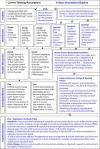Causes of metabolic syndrome and obesity-related co-morbidities Part 1: A composite unifying theory review of human-specific co-adaptations to brain energy consumption
- PMID: 25708524
- PMCID: PMC4335398
- DOI: 10.1186/2049-3258-72-30
Causes of metabolic syndrome and obesity-related co-morbidities Part 1: A composite unifying theory review of human-specific co-adaptations to brain energy consumption
Abstract
The medical, research and general community is unable to effect significantly decreased rates of central obesity and related type II diabetes mellitus (TIIDM), cardiovascular disease (CVD) and cancer. All conditions seem to be linked by the concept of the metabolic syndrome (MetS), but the underlying causes are not known. MetS markers may have been mistaken for causes, thus many treatments are destined to be suboptimal. The current paper aims to critique current paradigms, give explanations for their persistence, and to return to first principles in an attempt to determine and clarify likely causes of MetS and obesity related comorbidities. A wide literature has been mined, study concepts analysed and the basics of human evolution and new biochemistry reviewed. A plausible, multifaceted composite unifying theory is formulated. The basis of the theory is that the proportionately large, energy-demanding human brain may have driven co-adaptive mechanisms to provide, or conserve, energy for the brain. A 'dual system' is proposed. 1) The enlarged, complex cortico-limbic-striatal system increases dietary energy by developing strong neural self-reward/motivation pathways for the acquisition of energy dense food, and (2) the nuclear factor-erythroid 2-related factor 2 (NRF2) cellular protection system amplifies antioxidant, antitoxicant and repair activity by employing plant chemicals, becoming highly energy efficient in humans. The still-evolving, complex human cortico-limbic-striatal system generates strong behavioural drives for energy dense food procurement, including motivating agricultural technologies and social system development. Addiction to such foods, leading to neglect of nutritious but less appetizing 'common or garden' food, appears to have occurred. Insufficient consumption of food micronutrients prevents optimal human NRF2 function. Inefficient oxidation of excess energy forces central and non-adipose cells to store excess toxic lipid. Oxidative stress and metabolic inflammation, or metaflammation, allow susceptibility to infectious, degenerative atherosclerotic cardiovascular, autoimmune, neurodegenerative and dysplastic diseases. Other relevant human-specific co-adaptations are examined, and encompass the unusual ability to store fat, certain vitamin pathways, the generalised but flexible intestine and microbiota, and slow development and longevity. This theory has significant past and future corollaries, which are explored in a separate article by McGill, A-T, in Archives of Public Health, 72: 31.
Keywords: Cortico-limbic-striatal; Evolution and nutrition; Food addiction; Food micronutrient; Human brain metabolism; Malnutritive obesity (Malnubesity); Metabolic inflammation; Metabolic syndrome; Nuclear factor-erythroid 2-related factor 2 (NRF2); Obesity-related co-morbidities; Oxidative stress; Theory review.
Figures




References
LinkOut - more resources
Full Text Sources
Other Literature Sources
Miscellaneous

